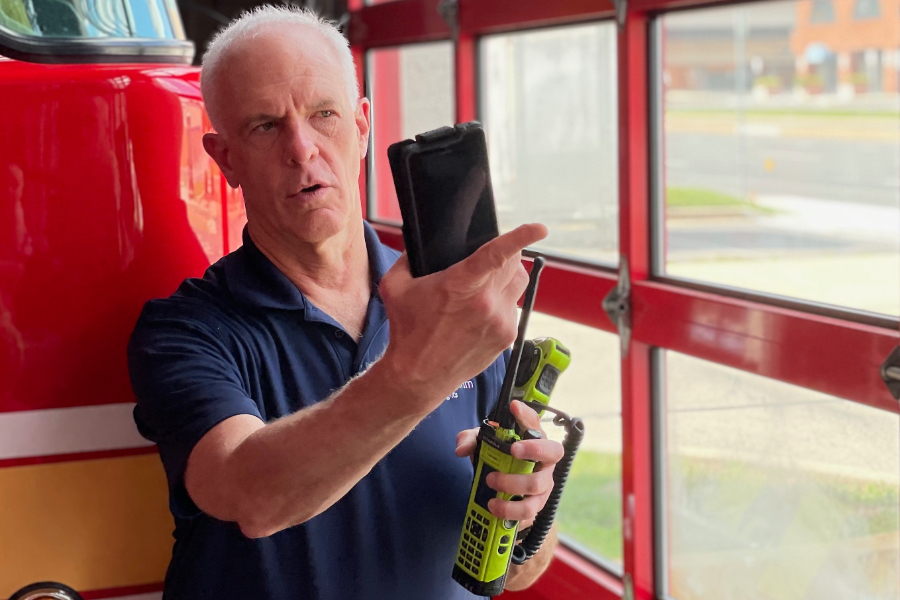Collaborative PS-IOT could supply missing pieces in public safety’s common operating picture
The explosive growth of the LTE ecosystem results from standardized open interfaces that enable the interconnection of innovative devices and networks. Much as LTE has grown thanks to a virtuous cycle spawned by standardized interfaces, so will future advances in public-safety command and control systems.
At Fire Rescue International 2021 in Charlotte, innovators brought at least three outstanding collaborative incident-management systems to the exhibit hall. While each of these collaborative command platforms presented agile interfaces that help incident responders and commanders navigate a wealth of data, the full power of these systems requires a much stronger level of cooperation from Public Safety Internet of Things (PS-IoT) players.
A growing number of nations now operate mission-critical LTE networks that serve the operational needs of public-safety agencies. These high-performance, nationwide public-safety broadband networks (NPSBNs) assure access, even when the commercial LTE networks encounter congestion during a disaster or large public gathering.
While creating these networks is an extraordinary achievement, the real value comes when application developers leverage this new communications fabric to produce tools that were impractical—if not impossible—before.
A prime example of a new toolset enabled by NPSBN high-speed mobile networking is the emerging set of collaborative command platforms. These single-pane-of-glass views on incident geography, resources, dispatch information, and command decisions deliver a common operating picture to incident responders and commanders. With companies that include 3AM Innovations, Adashi Systems, Tablet Command, and Unblur already deploying in forward-thinking fire service agencies around the United States and Europe, the landscape of command solutions has changed.
Today, these collaborative incident-command management systems provide informative and easy-to-manipulate user interfaces that blend CAD information, operational checklists, timers for milestone tracking, and you-see-what-I-see graphics. The resulting packages reduce radio traffic while boosting clarity for personnel engaged in the incident.
But as powerful as these packages are today, the software can accomplish much more if systematic integration with PS-IoT becomes possible.
To be sure, integration between these collaborative command platforms and external systems happens today. Adashi Systems, for example, supports a deep integration with the L3Harris Project 25 system to automate firefighter Personnel Accountability Reporting. The traditional time-consuming process of a vocal roll-call process that generates radio traffic is replaced with button pushes on an L3Harris XL radio portable. Another example is 3AM Innovations’ effort to integrate data from the RapidSOS clearinghouse into the 3AM Florian platform.
While these efforts deliver crucial new functionality for incident commanders and unit leaders, much more is possible if suppliers of firefighting vehicles and self-contained breathing apparatus (SCBA) instrument key components with open IoT interfaces.
When events go wrong on a fireground, the first indication is often frantic radio traffic that suggests a problem with the water supply. While an incident commander may hear the calls and begin considering how to react, gaining a complete picture of the problem is elusive. If the commander asks for an update on the status, the command will distract the harried pump operator from fixing the issue.
As a better alternative, suppliers of pump systems on fire apparatus could provide a wireless data source that reflects pump status. When integrated with a command system, the incident commander and sub-commanders instantly would see relevant status changes as pump operators engage pumps, consume scarce onboard water, receive water from supply lines, and discharge water on attack lines. Beyond early warnings when pump operators fail to establish an initial water supply, this information can provide a water-supply officer with signs of supply scarcity as hydrants in the grid are sapped.
SCBA air-supply and firefighter-down indications are other promising opportunities for integration with collaborative command platforms.
Vendors provide proprietary wireless systems today capable of relaying SCBA status information to the vendor’s status platform. The information gives incident commanders precious data on personnel accountability, air status, time on the scene, Personal Alert Safety System (PASS) alarm status, and more.
Unfortunately, today’s systems are closed proprietary silos that are not integrated into the powerful single-pane-of-glass command solutions. Command solutions can innovate with algorithms that smartly hide and expose data on a need-to-know basis that relieves incident commanders from information overload.
Real progress toward integrating these public safety IoT systems with collaborative command platforms will only come when industrial players put aside selfish proprietary interests and collaborate on interfaces that allow commanding platform access. While apparatus manufacturers, pump system builders, and SCBA suppliers may converge on an open IoT framework that makes information-rich command platforms possible, the reality is that customers must prime the standards pump. To accomplish this goal, fire-service organizations must contribute requirements to accredited standards organizations such as the NFPA, APCO, and ETSI.
With interface standards in place for status inquiries and alarm generation, new business models can arise that enable collaboration to extend to the Internet of Things supporting public-safety incident response.
One possibility is that each platform supplier enters into negotiations with the many innovators crafting IoT endpoints. Another option is for today’s public-safety information clearinghouses—for example, RapidSOS—to take on the role of acting as a hub between these IoT elements and collaborative command platform systems.
Regardless of the approach, getting the design of open interfaces and protocols in motion is an essential first step. Only when the broad ecosystem of PS-IoT suppliers and collaborative command platform innovators begin production of integrated solutions can the full promise of mission-critical LTE be realized.
Ken Rehbehn is a principal analyst at CritComm Insights. An industry analyst since 2002, Ken also serves as a firefighter in Montgomery County, Maryland, and is thankful every time he responds to a structure hosting an Emergency Responder Radio Coverage System (ERRCS).


















I agree that PS-IoT could play a big role in improving not only situational awareness of ongoing incidents, but also potentially pre-incident information which can then be used by responders when attending.
The issue I see right now is that there don’t seem to be many PS-IoT vendors out there. Market too immature due to lack of awareness among end-users? Or is PS-IoT being overlooked by IoT vendors focused more on enterprise?